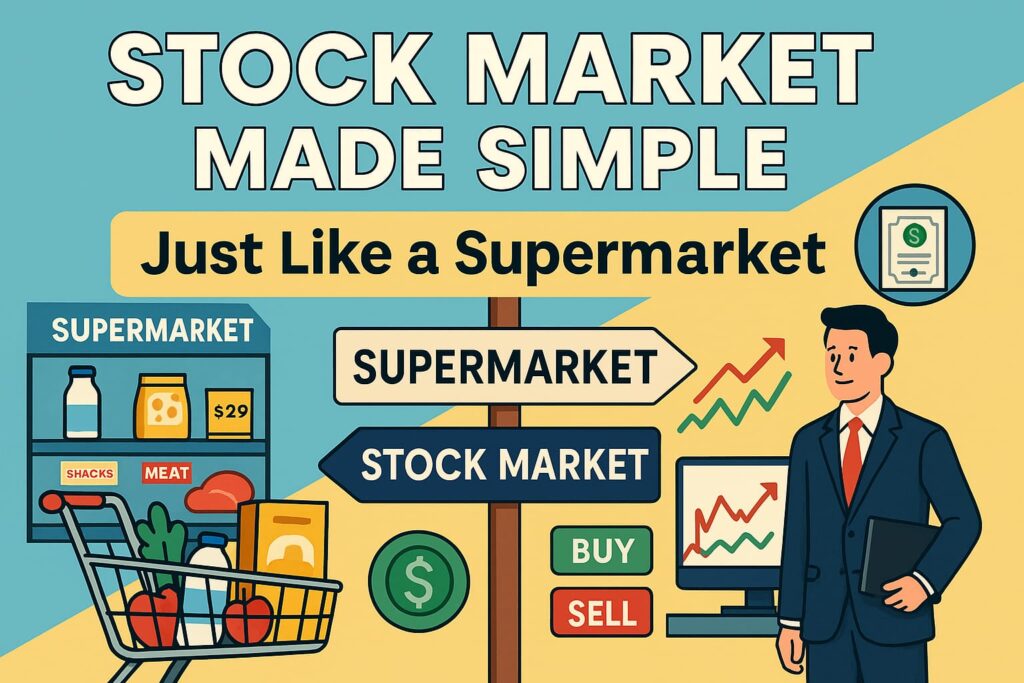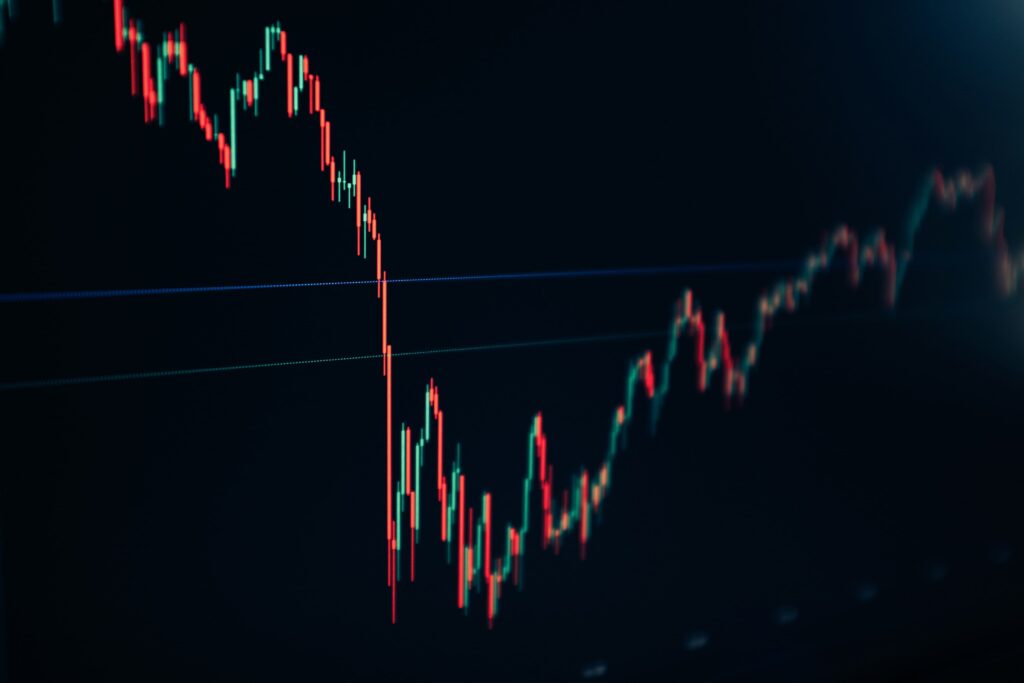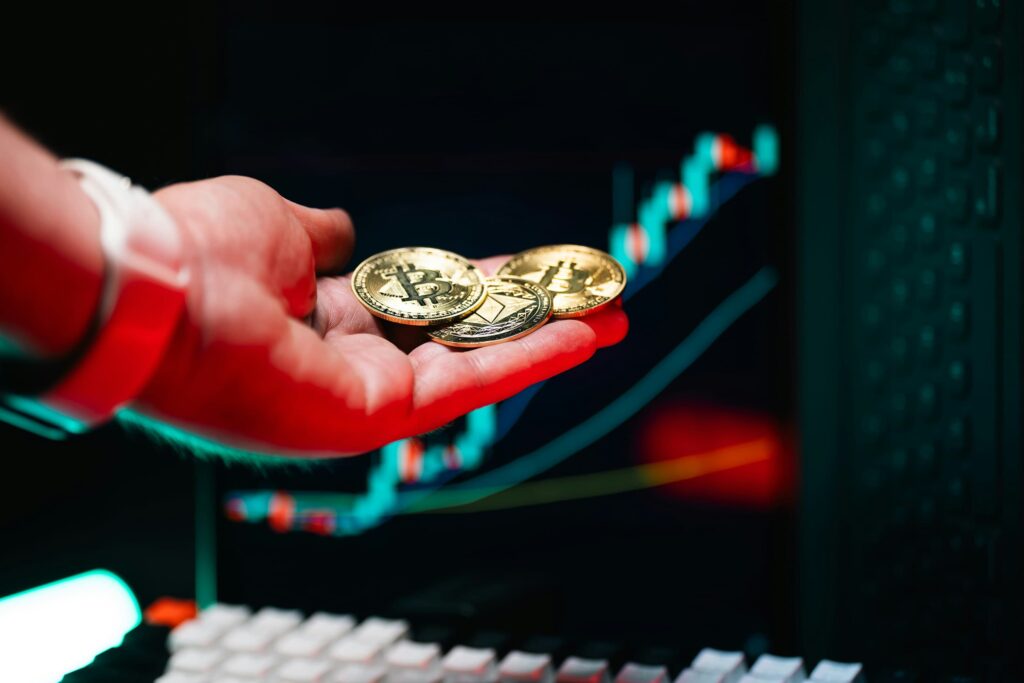
I have seen many articles written on this topic, but they all explain it in a very complex and technical way. Today, we will take the example of a supermarket to understand the stock market. Which will be easy for you to understand and for me to understand.
The stock market is like a supermarket where every product is a stock of a company. This stock market guide for beginners will tell you step-by-step how the stock market works, how investing in it works, and how you can invest in it if you want to. Apart from this, there is a lot more.
Just like you go to the market to buy groceries, similarly, in the stock market, you buy stocks of companies. When you buy stock in a company, it is as if you are buying a small part of that company, like picking up a cereal box.
Understanding the Supermarket Analogy
- Aisle (Sector): Just as there are sections for dairy, snacks, and meat, similarly, there are sectors like technology, healthcare, and banking in the stock market.
- Product (Share/Stock): Every product kept on the shelf is the stock of a company. Like one box of cereal = one share.
- Price Tag (Stock Price): Just like every product has a price, similarly, the stock also has a price that depends on demand and supply.
- Cashier/Broker: Just like you go to a cashier to buy things, you have to go to a broker who trades for you.
- Sale/Discount (Market Dip or Dividend): You must be aware of sales and discounts. Similarly, sometimes stocks are available cheaply when the market is low; buying at that time can be beneficial. Some companies also return a part of the profit to you, which is called a dividend.
- Shopping Cart (Portfolio): The total account of all the stocks you have is called your investment portfolio. What is a portfolio? If you want to know the details, click here.
This concept helps new learners understand how the price of a car works. Just like you don’t pick up things in a supermarket without a list or budget, you also need a purpose and research to buy stocks. A beneficial way to deal with these comparisons is given below:
| Supermarket 🛍️ | Stock Market 📈 | Explanation |
|---|---|---|
| Product (like a bottle of milk) | Shares | A share is a small part of a company, like a bottle of milk |
| Category (like dairy) | Sector (like Consumer Goods) | Similar companies are grouped, like dairy or snacks shelves. |
| Cart 🛒 | Portfolio | Your portfolio holds your selected stocks. Just like you keep your selected products in your cart. |
| Cashier | Broker | Shopping is finalised through the cashier, and stocks are purchased through a broker. |
| Price tag | Stock Price | Just as you pay a price when you buy a product, similarly, you will pay the stock price. |
| Sale | Price Drop | Just as you get a chance to buy cheap in a sale, similarly, you get a chance to buy cheap stock when the stock price falls. |
| Coupon | Dividend | Companies pay extra money (dividends) to some investors, just like a discount through coupons. |
Why are these comparisons important?
This concept makes complex concepts of risk management simple, without any technical details. Just like you make a list for shopping at the supermarket, look at the budget, and learn about products, for risk management, you need:
Purpose (list): Why are you investing? (Retirement, savings, etc.)
Knowledge (knowledge of products): Research companies and their stocks.
Estimation of market share (fees and risks): Understand broker fees and market risks.
This approach prepares you to make confident and smart investments as a beginner!
How the Stock Market Works

The stock market is a place where people buy and sell shares of companies. Just like people buy goods in a store, stocks are also traded here.
When a company goes public, it sells its shares in the market; this is called an IPO (Initial Public Offering). After this, people can buy or sell their shares on the exchange.
Now, what is a share exchange?
Share exchange is a process in which the shareholders of a company exchange their shares for the shares of another company, often during a merger or acquisition.
When you buy shares of a company, you become an owner of that company, though not at the same level, but you do stand out.
This means the more shares you have of that company, the more your value will increase.
During this time, if the company earns a profit, you will also benefit from it, sometimes in the form of dividends and sometimes by an increase in the share price.
Just as supermarkets operate every day, stock exchanges also have set trading hours, holidays, and rules. During trading hours, prices fluctuate according to supply and demand. For example, if a new product (a popular stock) suddenly becomes a hot item, its price increases just like a rare snack gets sold off the shelves quickly and is sold at a premium. In contrast, if a stock is not liked, its price falls just like a clearance sale at a grocery store.
Global Stock Exchanges and Markets
If you are looking for a stock market guide for beginners, it is important to understand that this world of investments is not just confined to one country; it is global. There are many stock exchanges around the world—dozens in number. In fact, by July 2025, there are approximately 78 major exchanges around the world. These are some of them
| Exchange | Location | Market Cap (USD) | Notes |
|---|---|---|---|
| NYSE, | USA | $31.7 trillion (2025) | The biggest exchange in the world, all types of companies. |
| Nasdaq, | USA | $20 trillion (2024) | “Tech giants like Apple and Amazon are more here.” |
| Shanghai, | China | $7.3 trillion (2025) | “Asia’s biggest market, for Chinese companies.” |
| NSE, | India | $5.1 trillion (2025) | “Asia’s biggest market for Chinese companies.” |
| HKEX, | Hong Kong | $5.2 trillion (2025) | “India’s top exchange, fast-growth market.” |
| LSE, | UK | $3.4 trillion (2024) | “Europe’s biggest market, most old companies.” |
How to invest?
If your broker offers international access, you can buy stocks from any country. For new investors, exchange-traded funds (ETFs) are an easy way—it’s like buying shares of several companies at once! For example, with one ETF, you can invest in several stocks on the Nasdaq or NSE without having to buy each stock separately.
Popular Trading Platforms Around the World
Just like every city has different stores, every region has its own special online brokers or trading platforms. As a beginner, it is important to know where you can start:
- Robinhood (USA): You can trade without paying a fee, and you can also use the app if you want.
- eToro (Global): This is a social trading site where you can follow other experienced investors and learn from how they do things.
- Zerodha (India): This is India’s most popular and affordable broker platform if you live there.
If you want to reach international markets, Interactive Brokers, IG, and Futu are the best platforms.
A lot of brokers also have demo accounts, which let you practice with fake money in real market conditions. This lets you learn how to trade without really losing anything.
Investor Mindset and Common Myths: Important thinking for beginners

Good investing is not just about investing money; it also involves correct thinking and mindset. So in this stock market guide for beginners, we will explain the mistakes that people make on a regular basis, which is very important to know.
Important Principles of Investing
- (Be Patient): Don’t expect quick profits. Give time to grow your investments. Patience in the stock market is a golden principle.
- (Control Emotions): Don’t sell your stocks out of fear, and don’t buy anything out of greed. Taking decisions on emotions is often harmful.
- (Diversify Your Portfolio): Never invest all your money in the stock of just one company. Include stocks of different companies and industries in your portfolio. This reduces the risk.
- (Create a Plan): What is your investing goal? Are you saving for retirement? Or to buy a house? Invest according to your goals.
Common Myths About Investing
“Myth” Investing = Gambling: This is the biggest misconception. In investing you are becoming a part of a business; you are betting on the growth of that company. This does not depend just on luck but on research and analysis.
“Myth” You need a lot of money to start: Absolutely not! You can start with a very small amount as well. Apps like Robinhood offer fractional shares, which means you can buy even a small part of a share.
“Myth” Only Experts Invest: Nowadays, thanks to the internet and online resources, anyone can learn and invest. Knowledge is power, and the more you learn, the better investor you will become. That’s why this stock market guide for beginners is here to help you!
Key Terminology (Supermarket Glossary)
Keeping your foot in the world of investing is like learning a new language. But don’t worry. The Stock Market Guide for Beginners is here to make things easier for you. We have tried to explain the important investing terms like the supermarket prices every day, so that they are easy to understand. This is your glossary so that you can roam the financial aisles with confidence.
Let’s understand the basic concepts:
🔑Term | What it Means (and How it’s Like Shopping)
- 📦Shares: This is a small part of ownership in a company. Suppose you buy 100 shares of “Zomato Company,” and the total shares of that company are 10,000. This means you own 1% of the company. And if the company earns a profit and gives a dividend of $10 per share, then you will get 100 x 10 = $1000.
- 📊Stocks: You invest your money in different companies, which means you buy their shares, like Reliance, Tata Motors, and Infosys. By combining all these shares, you make your “stock portfolio.” If the price of Reliance shares increases, then the value of your portfolio will also increase.
Just like you put different items of all brands in your grocery basket, when you put them all together, you have your full shopping list! - 💰Dividend: A dividend is that part of the company’s profits that is given to the shareholders.
It is like you are getting a special “cash-back” coupon or a small refund from the store just because you bought their product and kept it with you for some time. - 🧺Portfolio: Your portfolio is a collection of all your investments—stocks, bonds, and other assets that you have. Imagine your shopping cart filled with a variety of items for your weekly groceries that you choose on a personal basis.
- 💳Broker/Platform: This is the service or platform you use to buy and sell stocks. Think of it like the cashier or checkout counter in a supermarket where you complete your purchases.
Well-known examples are trading platforms such as Zerodha or Robinhood. - 📈Index, such as the S&P 500: A collection of leading businesses that represent the general state of the market is called an index.
Just like a supermarket’s “bestsellers list” of what’s selling the most and which brand is popular. - 📦Exchange: Traded Fund, or ETF. With an exchange-traded fund (ETF), you can purchase a variety of securities at once. Imagine picking up a prepackaged bundle that contains everything you need, rather than selecting several random items one at a time.
- 🐂Bull Market: When stock values are rising and investors are keen to make investments, a bull market is comparable to a Black Friday sale.
- Think of a supermarket with a large number of customers, empty shelves, and a cheerful atmosphere where everyone is buying.
- 🐻Bear market: Exactly the opposite of this, when prices are falling, people become surprised and sad, and there is peace in the market. Like an old store with fewer buyers, people are hesitant, shelves are full, but interest is low.
- 📈Capital gain. The profit you receive when you sell an investment (such as stock) for more than you paid for it initially is known as a capital gain. It’s similar to finding a rare collectible item at a store for a low price and then selling it for a huge profit later.
- 🌪Volatility: indicates how quickly the prices of a stock go up or down. Just as the price of some items in a supermarket often fluctuates due to sales or demand, the price of a volatile stock also often fluctuates and is often volatile.
- ✅Summary: These investing terms are no longer boring textbook concepts. They are now as simple and understandable as examples from your local supermarket. In the next sections, we will show you how real investing takes place using these terms.
Knowing the investing terms (and their similes) simplifies investing. Never forget, “You have to know what you’re buying.” If something is not clear to you, research it first, just as you read food labels before you buy.
📈How to Start Investing: Step-by-Step

If you are still with us, it means you are ready to invest. Here we have prepared a simple checklist which will make it easier for you.✅
1️⃣️: Define Your Investment Goals
You should know why you are investing and for what. And for how long do you want to invest? (short term or long term) Until your goal is clear, you cannot move forward. When your plan is ready and clear, it will help you a lot in taking action.
📌To build a house, to buy something, or for education.
2️⃣: Analyze Your Budget and Decide How Much to Invest
You should know how much you earn,💵 how much you spend, and how much you save.🏦
After that decide how much you have to invest and where. Start with a little and then gradually increase your investment. In the financial world this concept is called SIP (Systematic Investment Plan) which neither puts a burden on you nor makes it easy for you to plan.
3️⃣: Choose a Reputable Broking Platform
Choosing a good broker gives you not just one but many benefits. What should you look for when looking for a good broker?
✔️ Regulatory compliance and safety
✔️ Fund insurance (SIPC, FDIC protection).
✔️ User-friendly tools and dashboard (which make your experience better).
✔️ Multi-currency support (you can invest directly in US dollars).
Some reputed brokers
💼Interactive Brokers (IBKR)
💼Charles Schwab
💼Fidelity
💼TD Ameritrade
💼Saxo
Banks come under strict regulators (SEC, FINRA, FCA, etc.).🏛️
These are all the agencies that ensure the safety of your goods.
📊Bonus: Suppose you have reached here from any country other than the US. In that case, there is a lot for you here as well, because here, an updated, simplified, and practical broker comparison has been given for international investors, So that it becomes easier for you to choose the right broker.
🌐 Global Broker Comparison (2025)
| Broker | Fees & Commission | Best For | Countries Supported | Rating |
|---|---|---|---|---|
| Interactive Brokers (IBKR) | $0 – low fees on stocks, FX, options | Advanced traders, global access | 200+ countries | ⭐⭐⭐⭐⭐ |
| eToro | $0 stock commissions, FX spreads | Beginners, social trading | US, EU, UK, Asia, Australia | ⭐⭐⭐⭐ |
| Charles Schwab | $0 US stock trades | US residents, retirement accounts | USA only (limited intl access) | ⭐⭐⭐⭐ |
| TD Ameritrade (now under Schwab) | $0 stock trades | US investors, powerful platform | USA only | ⭐⭐⭐⭐ |
| Fidelity | $0 US stocks, mutual funds | Retirement, ETFs, long-term | USA, UK | ⭐⭐⭐⭐ |
| Saxo Bank | High minimum deposit (~$2,000) | European/Asian investors | EU, Asia, MENA | ⭐⭐⭐ |
| Zerodha | ₹20 per trade (India only) | Indian advanced users | 🇮🇳 India only | ⭐⭐⭐⭐ |
| Groww | ₹20 per trade, 0 for mutual funds | Indian beginners | 🇮🇳 India only | ⭐⭐⭐⭐ |
| DEGIRO | Low-cost European broker | Europe-based investors | 🇪🇺 EU, UK | ⭐⭐⭐⭐ |
| Revolut Trading | No commission, limited features | Simple investing (stocks, crypto) | UK, EU, some international | ⭐⭐⭐ |
✅ Global Broker Selection Checklist
| Factor | Why It Matters |
|---|---|
| 🌍 Country Availability | Some brokers (like TD Ameritrade) only support U.S. residents |
| 💰 Fees & Spreads | Go for $0 commission brokers if you’re starting out |
| 📱 Platform UX | Easy app/desktop interface, reliable trade execution |
| 🔒 Regulation | Must be regulated by FINRA (US), FCA (UK), SEBI (India), etc. |
| 🧠 Education & Tools | For beginners, brokers like eToro and Fidelity are helpful |
| 📈 Product Access | Stocks, ETFs, options, crypto, mutual funds, international |
🔚 Final Recommendations by User Type
| User Type | Suggested Brokers |
|---|---|
| 🧑💻 Beginner (Global) | eToro, Fidelity, Revolut Trading |
| 📊 Advanced Trader | Interactive Brokers, Saxo Bank |
| 🌱 Long-Term Investor | Charles Schwab, Fidelity, DEGIRO |
| 🇮🇳 India-specific | Zerodha, Groww, Angel One |
| 🇺🇸 US Resident | TD Ameritrade, Charles Schwab, Webull |
| 🇪🇺 European Investor | DEGIRO, eToro, Saxo Bank |
4️⃣ Fund Your Account
Fund Your Account: once you sign up, do not leave it empty. You can understand it like you go for window shopping.
Even if you do not go to buy anything, you get a desire for something that you cannot leave, and at that time you do not have cash, then how will you feel?
Believe me, the money you keep in your account will not be wasted, rather it will give you 100% profit, this is my personal experience. When and where will you have to buy something?
5️⃣ Monitor and Rebalance Your Portfolio
From time to time, keep checking your portfolio, and Rebalance it if possible. Buy some and sell some, but refrain from doing so continuously. Remember, investing is a marathon, not a sprint.


Pingback: Want to Save Money Fast? Start With These Tiny Shifts
Pingback: 7 Hard Truths I Learned About Stock Market Futures (That No One Tells You)